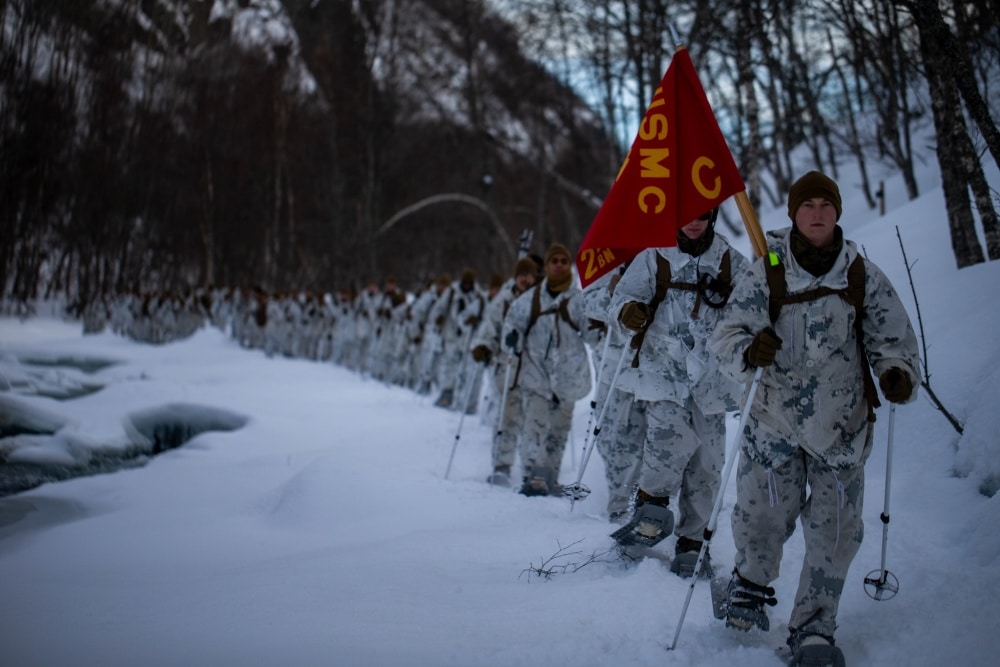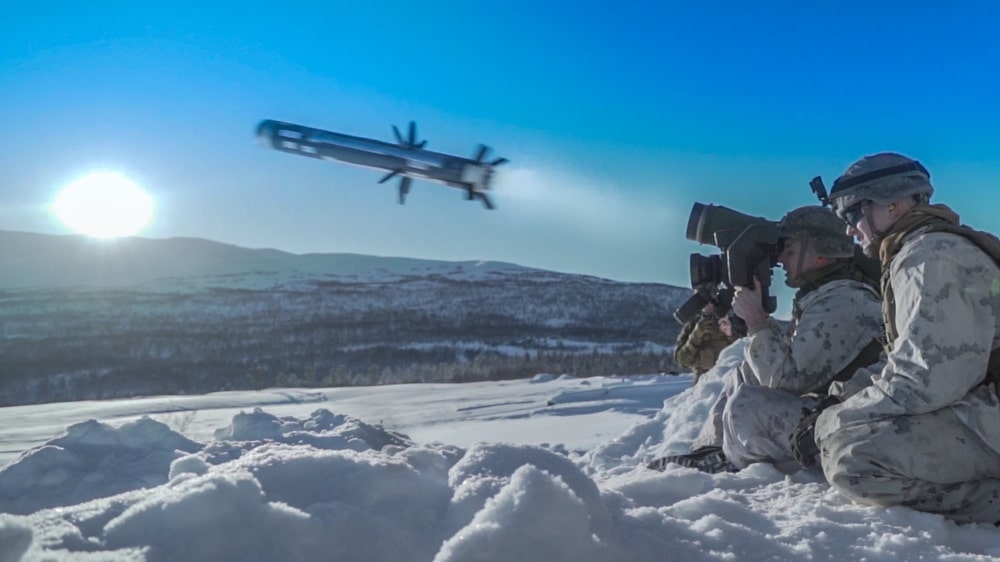This article by Nolan Peterson originally appeared on Coffee or Die
While the Marine Corps transforms to fight an island-hopping war against China in the Pacific Ocean, the military branch is also keeping its eye on another region, many miles and Fahrenheit degrees distant from the balmy Pacific atolls and islands, which has also become a prospective combat domain against both China and Russia — the Arctic.
This week some 350 Marines and sailors of 3rd Battalion, 6th Marine Regiment — the “Teufelhunden Battalion” — deployed to Norway for two months of Arctic warfare training and survival training alongside Norway’s armed forces.
The deployment marks the first rotation of a new round of Marine Rotational Force-Europe deployments, which the Marine Corps announced in August 2020.
“Norway offers challenging terrain and unique training opportunities to improve our cold-weather and mountain-warfare skills, enabling our force to fight and win in arctic conditions,” said Lt. Col. Ryan Gordinier, commander of 3rd Battalion, 6th Marine Regiment, in a release. “The ‘Teufelhunden Battalion’ looks forward to continuing our historic relationship and strengthening our alliance with the Norwegian military.”

Related: ARCTIC AND SPECIAL OPERATIONS: PREPARING FOR THE NEXT BATTLE
After a quarantine period, Norwegian Army instructors will lead the Marines and sailors through a variety of field training events in rugged Arctic conditions. An infantry battalion based out of Camp Lejeune in North Carolina, the Teufelhunden Battalion will also participate in Exercise Reindeer II, a major Norwegian army-led field exercise in northern Norway.
The US has a long defense relationship with Norway. The Scandinavian country agreed to welcome a rotational force of about 330 US Marines in Vaernes, Norway, beginning in January 2017. The Marines routinely train alongside their Norwegian allies in cold weather and mountain training, underscoring how the Arctic region has become a fault line between the US and its burgeoning crop of so-called near-peer adversaries — notably, China and Russia.
Russia’s military buildup in the Arctic has spurred closer military ties between the Nordic countries of Finland, Norway, and Sweden. In September, the defense ministers of those three countries signed a new defense agreement.
“On the military side, we clearly see a Russian buildup in the Kola Peninsula, a troop building up in Arctic region and it includes both the Navy, Air Force, and the Army,” Swedish Minister of Defense Peter Hultqvist said after the signing, referring to a peninsula in the far northwest of Russia.
“And we also see certain operative patterns, exercise patterns, that almost are similar to the Cold War,” Hultqvist said.

Changing climate conditions have steadily eroded the extent of the Arctic ice cap, opening up hitherto unavailable nautical passages to the north of Greenland. New Russian icebreakers have also made these more northern passages more practical.
Russia stood up a new Arctic Command and is building or refurbishing dozens of airfields across the Arctic. Today, Russia has some 34 military installations in or near the Arctic, according to news reports. Moreover, Russia has recently modernized its ballistic submarine fleet and added new nuclear-powered icebreakers.
China, too, has set its sights on the Arctic region. In January 2018, Beijing’s so-called Polar Silk Road Arctic strategy declared China to be a “near-Arctic state” — even though China’s nearest territory to the Arctic is some 900 miles away.
In May 2019, Secretary of State Mike Pompeo warned against China’s burgeoning interests in the Arctic by asserting that the US does not want “the Arctic Ocean to transform into a new South China Sea, fraught with militarization and competing territorial claims.”
In the South China Sea, Beijing has been transforming natural atolls into military outposts, spurring regional tensions over freedom of navigation rights in that body of water.
The US Navy routinely conducts so-called “freedom of navigation” missions in the contested region, sometimes skirting nearby atolls and islands over which China has claimed ownership to assert the ability of vessels under any nation’s flag to lawfully traverse through recognized international waterways.

Related: PROJECT ICEWORM: AMERICA’S SECRET NUKE TUNNELS BENEATH GREENLAND’S ICE
According to the Defense Department’s 2019 Indo-Pacific Strategy Report, China “seeks Indo-Pacific regional hegemony in the near-term and, ultimately…global preeminence in the long-term.”
With the Chinese threat in mind, the Marine Corps is pivoting toward a broader, servicewide focus on littoral combat reminiscent of America’s so-called Pacific Ocean “island-hopping” campaign during World War II.
The Marine Corps Warfighting Laboratory is currently experimenting with a new Marine littoral regiment formation, which is geared toward a war in the Pacific against China in which Marines would fight from small islands and atolls to support naval operations. This new combat formation will include a combat team, a logistics element, and an anti-air battalion — a light and agile composition that reflects the nature of Chinese threats in the Pacific theater.
Marine leaders say there’s a renewed focus on long-range precision fires, advanced reconnaissance capabilities, and cyberwarfare. Those priorities clearly underscore the stark differences between the projected nature of combat against China and what the past several generations of battle-hardened Marines have experienced on the battlefields of Iraq and Afghanistan.
To that end, the Marine Corps recently announced it was shedding its tank force, and discussions are underway about the utility of its long-range artillery, as well.
The Marine Corps’ operative transformational plan — the Force Plan 2030 — outlines the branch’s primary function is to be “the nation’s naval expeditionary force-in-readiness.” The document makes clear that the Marine Corps is shifting its “primary focus to great power competition and a renewed focus on the Indo-Pacific region.”
The Marine Corps has a long history of operating in combat theaters encompassing myriad environmental conditions that span the gamut from tropical Pacific islands to the frozen Chosin Reservoir and the Hindu Kush. As this week’s deployment to Norway makes clear, the next war is not always the one you planned for.
More articles from Coffee or Die:


